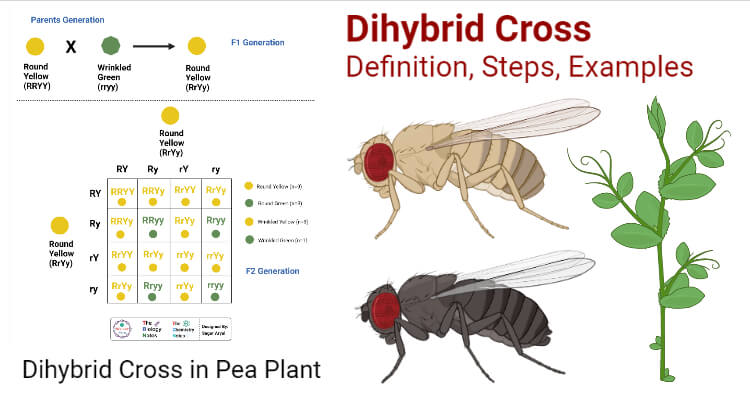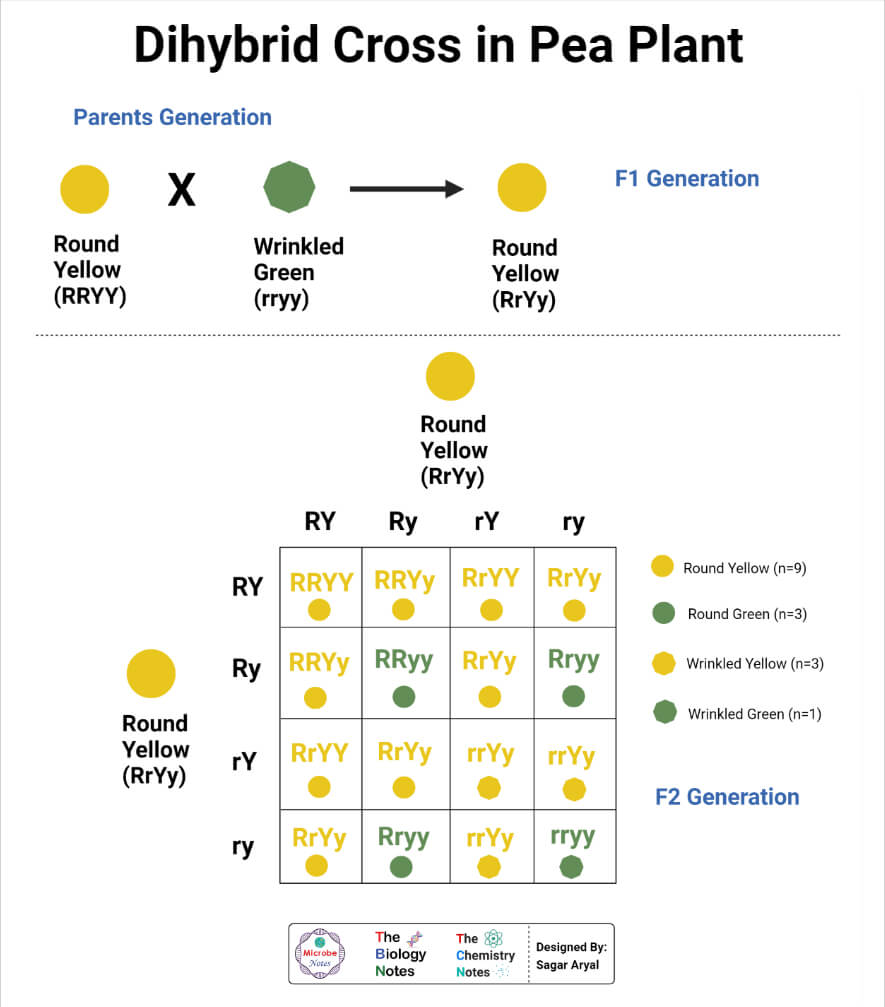Interesting Science Videos
Dihybrid Cross Definition
A dihybrid cross is a type of genetic cross between two individuals with either homozygous or heterozygous genotypes of two characters or traits.
- The dihybrid cross is different from the monohybrid cross, which only involves a single genetic character or trait.
- Dihybrid crosses are more complex than monohybrid crosses as these involve more than one genetic trait where the parents can be either homozygous or heterozygous for these traits.
- The dihybrid cross is used as a method to determine or prove the law of independent assortment as it proves that two characters segregate independently of one another. However, it only works in the case of genes that are not linked and are present on different chromosomes.
- The number of gametes formed during a dihybrid cross is more than those during a monohybrid cross, as two separate genes are involved in the case of a dihybrid cross.
- The number of offsprings is also more in the case of a dihybrid cross. These have a more phenotypic variation than the ones obtained from monohybrid crosses.
- The phenotypic ratio of the offsprings in the first generation after a dihybrid cross is written as 9:3:3:1. The genotypes of the offsprings are even more diverse with the ratio of 1:2:2:4:1:2:1:2:1.

Steps/Process
The following are the steps to be followed in order to conduct a dihybrid cross between two individuals;
1. Selection of parents
- The first step in the dihybrid cross is the selection of characters as well as parents that are to be crossed.
- The pure lines are obtained by selfing the individuals for three generations which confirms the presence of pure lines.
2. Designation for the characters
- The alleles for the two characters selected are designated with certain alphabet characters. The dominant alleles are indicated by upper case letters, whereas the recessive alleles are indicated with lower case letters.
3. Punnet square
- Since gametes are to be formed for fertilization, the gametes are formed. Four distinct gametes are formed while studying the two characters.
- The Punnet square is set up by listing the phenotype and genotype of the parents. The gametes will be haploid as a result of meiotic division.
- The possible combinations of the genotypes are filled into the Punnet square, and all combinations are equally possible as the process of fertilization is random.
4. Determination of ratios
- Once all the combinations are determined, the phenotypic and genotypic ratios of the offsprings are determined noted down.
Examples of Dihybrid Cross
1. Dihybrid cross in Pea plants
- An example of a dihybrid cross is the cross between a homozygous pea plant with round yellow seeds and wrinkled green seeds.
- The round yellow seeds are represented by RRYY alleles, whereas the wrinkled green seeds are represented by rryy. The gametes formed from these alleles are RY and ry.
- When the two parents are crossed, the F1 hybrids with the RrYy allele are formed. The hybrids contain round yellow seeds (RrYy) with the dominant R allele for roundness and the dominant Y allele for the yellow color.
- The four alleles can combine in four different combinations; RY, Ry, rY, and ry. the four alleles are assorted randomly to produce four types of gametes.
- The gametes unit at random during fertilization to produce sixteen types of individuals in the F2 generation.
- The hybrids occur in the ratio of 9 round yellow, 3 round green, 3 wrinkled yellow, and 1 wrinkled green.

2. Dihybrid cross in Drosophila
- Another example of a dihybrid cross can be observed in the case of homozygous long-winged and black-bodied Drosophila and vestigial-winged and grey-bodied fly.
- The F1 generation hybrids obtained are long-winged grey-bodied Drosophila fly. The hybrids, after mating with each other to produce the F2 generation.
- The F2 generation includes 9 long-winged grey bodies, 3 long-winged black-bodied, 3 vestigial-winged grey-bodied, and 1 vestigial winged black-bodied Drosophila.
References and Sources
- Verma PS and Agarwal VK (3005). Cell Biology, Genetics, Molecular Biology, Evolution, and Ecology. Multicolored Edition.
- https://geneticsstudy.blogspot.com/2009/08/punnetts-gametic-checkerboard-method.html – 9%
- https://thefactfactor.com/facts/pure_science/biology/genetics/mendels-dihybrid-cross-experiment/10026/ – 5%
- https://pediaa.com/difference-between-monohybrid-cross-and-dihybrid-cross/ – 5%
- https://www.thoughtco.com/dihybrid-cross-a-genetics-definition-373463 – 4%
- https://microbenotes.com/monohybrid-cross/ – 4%
- https://www.thoughtco.com/independent-assortment-373514 – 2%
